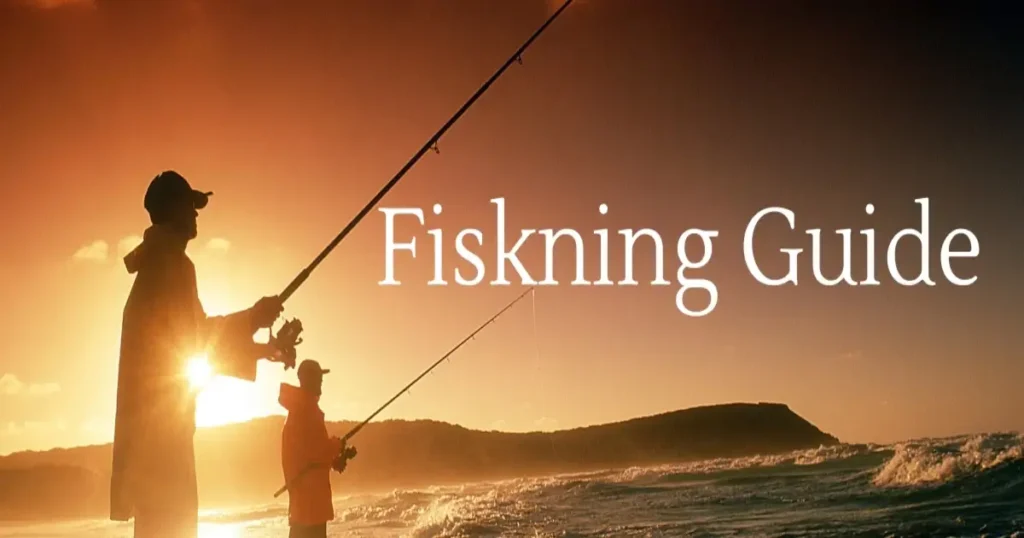In some parts of the world, fishing is known as “fiskning” and has been a much-valued pastime for many years. Whether you are new to fishing or an experienced angler who desires to cast your first line, the sport can be a calming outdoor retreat and an opportunity to bond with nature. This extensive guide covers fishing background, methods employed, gear used, and environmental impacts, thus giving readers all they need to become skilled anglers.
Table of Contents
Introduction to Fiskning (Fishing): A Time-Honored Tradition
Fishing is not only a hobby, but also a way of life for some people. Fishermen used fishing as their source of food universally or for fun and spiritual practices in different communities. Up to this day, millions of people still find it recreational. If you want a peaceful day on the lake or an adventurous time deep sea fishing, there’s something deeply gratifying about fiskning as an art form.
The History of Fiskning
Fishery has very deep roots in the history of man. From archaeological findings, humans have been fishing for over forty thousand years. Early ways encompassed using tools like spears and harpoons which later on developed into more complex techniques and equipment involved in catching fish. This act was not only vital as food but also had social and cultural implications in different societies.
Ancient Fishing Techniques
Various ancient civilizations such as Egyptians, Greeks, and Romans came up with numerous techniques of fishing. The Egyptians were using woven nets and harpoons along the Nile River while Greeks and Romans promoted the use of lines, hooks and fish traps. These early inventions laid foundation to contemporary fishing skills indicating human beings’ creativity and adaptability.
Evolution of Fishing Equipment
Fishing equipment advanced with industrial revolution.The spinning reel that was developed duringthe 19thcentury changed this sport making it easierand productive.Today angling gears are specialized towards certain kinds of fishing or aquatic environments.Coming from high-tech rods to advanced sonar systems, trade tools have undergone significant changes.
Types of Fiskning
Based on environment type and technique utilized, fishing can be categorized into several types.In this article we look at some most common forms:
Freshwater Fishing
This occurs in rivers,lakes,and streams.The easiest form for people who are beginning their new hobbies.Since common fresh water fish species include bass,trout,and catfish,it is advisable not to worry too much when going in for this kind of fishing.Many people only like this method of angling since it allows them access quiet environments and fish from a wide variety.
River Fishing
Rivers have different currents and depths that make them dynamic. Anglers often use fly fishing techniques, which involve casting lightweight artificial flies to attract fish. Fly fishing is a favorite among seasoned anglers who relish the challenge of outsmarting elusive fish through their sport’s skill and accuracy.
Lake Fishing
Lakes, on the other hand, are calm waters suited to families and beginners. Hence, techniques involved in lake fishing such as bait fishing using live or artificial bait are popular.Anglers can select from diverse species including pike, perch and walleye.Fishing at the lake is very peaceful for one to unwind and experience nature.
Saltwater Fishing
In oceans and seas, saltwater fishing takes place with its particular challenges and rewards. It can include coast shore fishing or deep sea expeditions. The ocean’s vastness and marine life diversity offers limitless possibilities for adventure and exploration.
Shore Fishing
Shore fishing is casting from the shoreline or piers. It is convenient for people without boats. Standard methods of beach or surfcasting that use heavy lines and weights to cast bait are used far out into the ocean. Shore fishing gives a simple but rewarding opportunity to feel what it means to catch fish.
Deep-Sea Fishing
Deep-sea fishing occurs quite far from the shore, where large predators like marlins, tunas, swordfishes are being targeted. This method of angling requires special equipment such as heavy-duty rods, reels sometimes harnesses worn during intense battle with big game fish. Anglers from every part of the world come here because deep-sea angling is exciting as well as challenging.
Ice Fishing
Winter ice covers over lake water bodies in some parts of the world bringing forth ice fishing that only happens at such periods. Anglers usually drill holes through ice and apply different methods to catch fish beneath it. Common in northern areas, ice fishing targets species including perch, pike and walleye.Fishing together on frozen lakes is a tradition that remains etched in our minds forever.
Essential Fiskning Gear
For your fishing trip to be successful you need proper gear.Here are some vital items that every angler must have:
Fishing Rods
Different kinds of fishes require various types of rods which come in varying length materials and strength.Whether made from fiberglass, graphite or composite blends these popular materials allow one choose accordingly.The right choice depends on factors such as target fish species,fishing terrain,and an angler’s preference.
Reels
These devices attached to rods store,release,and retrieve lines used for angling.The various kinds of fishing reels include:
- Spinning Reels: These are best suited to beginners who find them versatile and easy to use.
- Baitcasting Reels: More control and accuracy which make them more preferred than other type by veterans.
- Fly Reels: They are constructed specifically for fly fishing, releasing the line smoothly.
Fishing Lines
Lines used in angling have varying features such as strength or elasticity. The common types of these lines include:
- Monofilament: It is flexible enough to adapt to an environment one may come across at affordable prices.
- Braided Line: Designed with sturdy materials,the braided line will work well in thick cover and pulling giant fish.
- Fluorocarbon: Being clear underwater, it is almost invisible when using lures in clean waters that contain skittish fish.
Hooks and Bait
The choice of bait lure or hook determines how well one can attract their catch. Different hooks are shaped differently to meet various requirements for different fishing techniques. Bait can either be alive like worms or minnows or artificial like lures and flies.
Additional Gear
Similarly, additional gear includes the following:
- Tackle Box-where hooks, lures and small things can be kept organized
- Fishing Net-used for safe landing of fishes
- Fishing Vest-Store tools and accessories conveniently
- Cooler– Keeps your catch fresh
Techniques and Tips for Successful Fiskning
Learning different methods of fishing increases your chances of success.Here we provide some professional tips on varied fishing styles:
Casting Techniques
The ability to cast properly ensures that you reach the desired spot where fish will not suspect anything. Train yourself on these casting techniques:
- Overhead Cast – It is mainly considered as the basic technique suitable for the first timers or novices.
- Sidearm Cast – This type enables one to throw under obstacles such as tree branches.
- Roll Cast – This style is crucial when casting flies in tight places.
Retrieving Techniques
By the manner you retrieve your line, it is possible to simulate the movement of prey that lures fish into biting. Just try these techniques:
- Slow and Steady: Suitable for wary fish.
- Stop-and-Go: Produces wounded prey that provokes predator instincts.
- Jerking Motion: Results in irregular movements which magnetize aggressive fish.
Understanding Fish Behavior
Knowing habits and behaviors of target species can enhance fishing success significantly. Look at:
- Feeding Times: Fish are often more active during dawn and dusk.
- Habitat Preferences: Different species prefer particular underwater structures such as rocks, weeds or drop-offs.
- Seasonal Patterns: A change in fish behavior depends on seasons thereby influencing feeding and movement patterns.
Environmental Impact of Fiskning
As an angler, it’s important to consider the environmental impact of fishing and use sustainable practices that will enable aquatic ecosystems to be preserved for future generations.
Catch and Release
Catch and release is a conservation practice where anglers release fish back into the water after catching them. This helps maintain fish populations and ensures the sustainability of fisheries. Observe these steps when practicing catch and release:
- Use barbless hooks when possible to minimize harm inflicted on caught fishes.
- Hold fishes gently with wet hands before releasing them back into water bodies.
- Fast release reduces stress in fishes due human disturbance during capture.
Avoiding Overfishing
Overfishing depletes fish populations, and disrupts ecosystems leading to unbalanced marine biodiversity. To avoid overfishing:
- Comply with all local fishing regulations including size limits as well as bag limits.
- Observe breeding seasons so that there is time for fish to reproduce.
- Buy seafood from sustainable sources thus supporting sustainable fisheries.
Reducing Pollution
Fishing activities often result in pollution which affects aquatic environments negatively. For instance, take these steps towards curbing pollution:
- Dispose off your waste properly without leaving any trash behind you.
- Use biodegradable baits, lines and other fishing accessories.
- Engage in community cleanup campaigns for local waters such as rivers that are affected by pollution from fishing activities.
Fiskning Destinations: Top Spots Around the World
For adventure seekers who want an ultimate fishing experience, it can be worthwhile to explore some of the top fishing destinations. Check out some of the best places to go fishing in the world:
North America
- Alaska, USA: Known for its salmon and halibut fishing.
- Florida Keys, USA: Good for both inshore and offshore angling activities.
- British Columbia, Canada: Popular for its salmon and trout fisheries.
Europe
- Norway: Famous for cod, halibut and sea trout fishing activities.
- Scotland: Great fly fishing spots abound with plenty of salmon and trout in rivers; lochs too have similar conditions.
- Spain: Home to a variety of fish including carp and catfishes among others.
Asia
- Thailand: Is famous for freshwater angling done on lakes and rivers here.
- Japan: Has unique opportunities like ice or deep-sea angling that no one else has.
- Maldives: For example big game fish such as marlins and tunas are available here.
Australia and Oceania
- New Zealand: Best known for trout and fly-fishing internationally .
- Australia: Offers diverse fishing opportunities, from barramundi in the north to tuna in the south.
- Fiji: Known for its pristine waters and abundant marine life.
Conclusion
Fishing is a versatile and rewarding activity that offers countless benefits, from relaxation and connection with nature to the thrill of the catch. By understanding the history, techniques, and equipment involved and practicing sustainable fishing methods, you can enjoy this beloved pastime while preserving aquatic ecosystems for future generations. Whether casting a line in your local river or embarking on an international fishing adventure, fishing provides endless opportunities for adventure and enjoyment.







